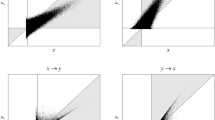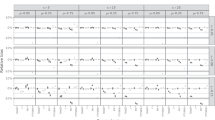Summary
Graphical methods for the discovery of structural models from observational data provide interesting tools for applied researchers. A problem often faced in empirical studies is the presence of latent confounders which produce associations between the observed variables. Although causal inference algorithms exist which can cope with latent confounders, empirical applications assessing the performance of such algorithms are largely lacking. In this study, we apply the constraint based Fast Causal Inference algorithm implemented in the software program TETRAD on a data set containing strategy and performance information about 608 business units. In contrast to the informative and reasonable results for the impirical data, simulation findings reveal problems in recovering some of the structural relations.







Similar content being viewed by others
Notes
1 Meanwhile TETRAD III and a new Java version TETRAD IV are freely available from the TETRAD project homepage http://www.phil.cmu.edu/projects/tetrad/. Since the search algorithms have been slightly improved in this newer versions (email correspondence with Richard Scheines), all analyses reported in this study have been performed with TETRAD III.
2 We thank an anonymous reviewer for suggesting these simulations.
References
Acid, S. & de Campos, L. (2003), “Searching for Bayesian Network Structures in the Space of Restricted Acyclic Partially Directed Graphs”, Journal of Artificial Intelligence Research 18, 445–490.
Ailawadi, K., Farris, P. & Parry, M. (1999), “Market Share and ROI: Observing the Effect of Unobserved Variables”, International Journal of Research in Marketing 16, 17–33.
Annacker, D. & Hildebrandt, L. (2004), “Unobservable Effects in Structural Models of Business Performance”, Journal of Business Research 57, 507–517.
Bagozzi, R. & Baumgartner, H. (1994), “The Evaluation of Structural Equation Models and Hypothesis Testing”, in Principles of Marketing Research, R. Bagozzi, ed., Basil Blackwell, Cambridge, 386–422.
Bollen, K. (1989), Structural Equations With Latent Variables, Wiley, New York.
Boulding, W. & Staelin, R. (1993), “A Look on the Cost Side: Market Share and the Competitive Environment”, Management Science 12, 144–166.
Browne, M. & Cudeck, R. (1993), “Alternative Ways of Assessing Model Fit”, in K. Bollen & J. Long, eds., Testing Structural Equation Models, Sage, Newbury Park, 136–162.
Buzzell, R. & Gale, B. (1987), The PIMS Principles, Free Press, New York
Cliff, N. (1983), ‘Some Cautions Concerning the Application of Causal Modeling Methods’, Multivariate Behavioral Research 18, 115–126.
Cooper, G. (1999), “An Overview of the Representation and Discovery of Causal Relationships Using Bayesian Networks’, in Computation, Causation and Discovery, G. Glymour & G. Cooper, eds., MIT Press, Cambridge, 3–62.
Cooper, G. & Herskovits, E. (1991), “A Bayesian Method for Constructing Bayesian Belief Networks from Databases”, in Proceedings of the Conference on Uncertainty in Artificial Intelligence, Morgan-Kaufman, San Francisco, 86–94.
Dawid, A. (1979), “Conditional Independence in Statistical Theory”, Journal of the Royal Statistical Society 41, B, 1–31.
Elidan, G. & Friedman, N. (2003), “The Information Bottleneck EM algorithm”, in Proceedings of the Ninetieth Conference on Uncertainty in Artificial Intelligence, Morgan Kaufmann, San Francisco, 200–208.
Elidan, G., Lotner, N., Friedman, N. & Koller, D. (2001), “Discovering Hidden Variables: A Structure-Based Approach”, in Advances in Neural Information Processing Systems 13 (NIPS 2000), T. Leen, T. Diettrich & V. Tresp, eds., MIT Press, Cambridge, 479–485.
Freedman, D. (1987), “As Others See Us: A Case Study in Path Analysis”, Journal of Educational Statistics 12, 101–128.
Griliches, Z. (1974), “Errors in Variables and Other Unobservables”, Econometrica 42, 971–998.
Harwood, S. & Scheines, R. (2002), “Genetic Algorithm Search Over Causal Models”, Technical Report CMU-Phil-131, Carnegie Mellon University, Pittsburgh.
Hildebrandt, L. & Buzzell, R. (1991), “Product Quality, Market Share, and Profitability: A Causal Modelling Approach”, Working Paper 91-045, Harvard Business School, Cambridge.
Hildebrandt, L & Temme, D. (2004), “The Model by Phillips, Chang and Buzzell Revisited—the Effects of Unobservable Variables”, in The Profit Impact of Marketing Strategy: Retrospect and Prospects, P.W. Farris & M.J. Moore, eds., Cambridge University Press, Cambridge, 153–187.
Heckerman, D., Meek, C. & Cooper, G. (1999), “A Bayesian Approach to Causal Discovery”, in Computation, Causation and Discovery, G. Glymour & G. Cooper, eds., MIT Press, Cambridge, 141–165.
Hu, L. & Bentler, P. (1999), “Cutoff Criteria for Fit Indexes in Covariance Structure Analysis: Conventional Criteria Versus New Alternatives”, Structural Equation Modeling 6, 1–55.
Hu, L. & Bentler, P. (1998), “Fit Indices in Covariance Structure Modeling: Sensitivity to Underparameterized Model Misspecification”, Psychological Methods 3, 424–453.
Jacobson, R. (1990), “Unobservable Effects and Business Performance”, Marketing Science 9, 74–85.
Jöreskog, K & Sörbom, D. (1996), LISREL 8: User’s Reference Guide, Scientific Software, Chicago.
Lacruz, B., Lasala, P. & Lekuona, A., (2001), Selecting Dynamic Graphical Models with Hidden Variables from Data, Computational Statistics, 16, 173–194.
Laurent, G. (2000), “Improving the External Validity of Marketing Models: A Plea for More Qualitative Input”, International Journal of Research in Marketing 17, 177–182.
Lauritzen, S., Dawid, P., Larsen, B. & Leimer, H. (1990), “Independence Properties of Directed Markov Fields”, Networks 20, 491–505.
Lee, S. & Hershberger, S. (1990), “A simple rule for generating equivalent models in covariance structure modelling”, Multivariate Behavioral Research 25, 313–334.
MacCallum, R., Roznowski, M. & Necowitz, L. (1992), “Model Modification in Covariance Structure Analysis: The Problem of Capitalization On Chance”, Psychological Bulletin 111, 490–504.
Nachman, I., Elidan, G. & Friedman, N. (2004), “‘Ideal Parent’ Structure Learning for Continuous Variable Networks”, in Proceedings of the Twentieth Conference on Uncertainty in Artificial Intelligence, Morgan Kaufmann, San Francisco.
Pearl, J. (1988), Probabilistic Reasoning in Intelligent Systems, Morgan-Kaufman, San Mateo.
Pearl, J. (1988), “Graphs, Causality, and Structural Equation Models”, Sociological Methods and Research 27, 226–284.
Pearl, J. (2000), Causality: Models, Reasoning, and Inference, Cambridge University Press, Cambridge.
Phillips, L., Chang, D. & Buzzell, R. (1983), “Product Quality Cost Position, and Business Performance: A Test of Some Key Hypotheses” Journal of Marketing 47 (Spring), 26–43.
Richardson, T. (1996), “A Discovery Algorithm for Directed Cyclic Graphs”, in Proceedings of the 12th Conference on Uncertainty in Artificial Intelligence, Morgan Kaufmann, San Francisco, 454–461.
Scheines, R., Spirtes, P., Glymour, C. & Meek, C. (1994), TETRAD II: Tools for Causal Modeling, USer’s Manual, Lawrence Erlbaum, Hillsdale.
Scheines, R., Spirtes, P., Glymour, C., Meek, C. & Richardson, T. (1998), “The TETRAD Project: Constraint Based Aids to Causal Model Specification”, Multivariate Behavioral Research 33, 65–117.
Scheines, R., Spirtes, P., Glymour, C., Meek, C. & Richardson, T. (1999), “Truth Is Among the Best Explanations: Finding Causal Explanations of Conditional Independence and Dependence”, in Computation, Causation, and Discovery, G. Glymour & G. Cooper, eds., MIT Press, Cambridge, 167–209.
Shipley, B. (1997), “Exploratory Path Analysis with Applications in Ecology and Evolution”, American Naturalist 149, 1113–1138.
Shipley, B. (2000), Cause and Correlation in Biology: A User’s Guide to Path Analysis, Structural Equations and Causal Inference, Cambridge University Press, Cambridge.
Silva, R., Scheines, R., Glymour, C. & Spirtes, P. (2003), “Learning Measurement Models for Unobserved Variables”, in Proceedings of the Nineteenth Conference on Uncertainty in Artificial Intelligence, Morgan Kaufmann, San Francisco.
Spirtes, P., Glymour, C. & Scheines, R. (2000), Causation, Prediction, and Search, 2. ed., MIT Press, Cambridge.
Spirtes, P., Meek, C. & Richardson, T. (1999), “An Algorithm for Causal Inference in the Presence of Latent Variables and Selection Bias”, in Computation, Causation, and Discovery, G. Glymour & G. Cooper, eds., MIT Press, Cambridge, 211–252.
Spirtes, P., Richardson, T., Meek, C., Scheines, R. & Glymour, C. (1996), “Using D-separation to Calculate Zero Partial Correlations in Linear Models with Correlated Errors”, Technical Report CMU-Phil-72, Canegie Mellon University, Pittsburgh.
Spirtes, P., Richardson, T., Meek, C., Scheines, R. & Glymour, C. (1998), “Using Path Diagrams as a Structural Equation Modeling Tool”, Sociological Methods and Research 27, 182–225.
Stelzl, I. (1986), “Changing a Causal Hypothesis Without Changing the Fit: Some Rules for Generating Equivalent Path Models”, Multivariate Behavioral Research 21, 309–331.
Verma, T. (1993), “Graphical Aspects of Causal Models”, Technical Report R-191, Computer Science Department, UCLA, Los Angeles.
Verma, T. & Pearl, J. (1990), “Equivalence and Synthesis of Causal Models”, in Proceedings of the Sixth Conference on Uncertainty in Artificial Intelligence, Morgan Kaufmann, San Francisco, 220–227.
Acknowledgements
The author thanks the two anonymous reviewers for their valuable comments and suggestions.
Author information
Authors and Affiliations
Appendix
Appendix
Rights and permissions
About this article
Cite this article
Temme, D. Constraint-based inference algorithms for structural models with latent confounders— empirical application and simulations. Computational Statistics 21, 151–182 (2006). https://doi.org/10.1007/s00180-006-0257-8
Published:
Issue Date:
DOI: https://doi.org/10.1007/s00180-006-0257-8




